
Bismillaher Rahmanir Rahim.
Assalamu Alaikum Wa Rahmatullahi Wa Barakatuhu
Dear Companions Today I want to share with you some words about the evils of killing foetuses.Welcom to this post and congratulations to all
Ghee, also known as clarified butter, is a staple in many South Asian, Middle Eastern, and Ayurvedic culinary traditions. Known for its rich, nutty flavor and extensive health benefits, it has become increasingly popular worldwide. This golden, fragrant cooking fat is revered for its high smoke point, long shelf life, and versatility. Below is a detailed exploration of how ghee is made, what makes it unique, its nutritional value, and its potential benefits.
How Ghee is Made
Ghee is traditionally made by simmering unsalted butter over low heat until the milk solids separate from the fat. The process involves patience and attention to ensure the perfect balance of aroma, color, and consistency. Here’s a step-by-step look into the process:
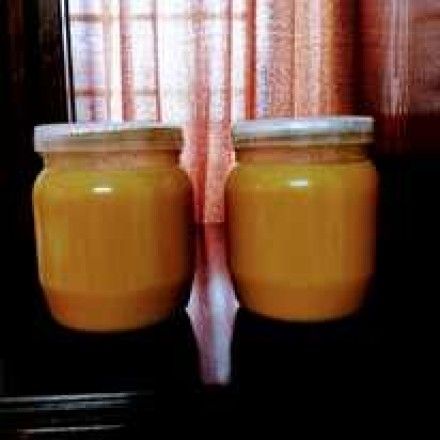
source
Selecting the Butter: High-quality unsalted butter is essential for making ghee. Organic and grass-fed butter is often preferred, as it tends to contain higher levels of omega-3 fatty acids and conjugated linoleic acid (CLA), which contribute to ghee's health benefits.
Heating and Simmering: The butter is melted in a heavy-bottomed saucepan over medium heat. As the butter melts, it separates into three layers: frothy foam on top, clear yellow fat in the middle, and milk solids at the bottom.
Skimming and Stirring: The foam on the top is skimmed off periodically as the butter continues to simmer. The heat is kept low to prevent burning. Gradually, the water content evaporates, and the milk solids begin to settle at the bottom.
Browning the Solids: Once the milk solids at the bottom start to turn golden brown, they impart a nutty aroma to the ghee. This is an essential stage, as the browning enhances the flavor without burning the solids.
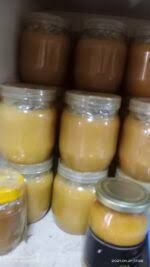
source
Straining the Ghee: The clarified butter is then carefully strained through a fine-mesh sieve or cheesecloth into a clean jar, leaving the browned milk solids behind. The result is a golden liquid with a smooth, rich texture.
Ghee has a long shelf life due to the removal of water and milk solids, which makes it resistant to spoiling. It can be stored at room temperature for months and may last even longer if refrigerated.
What Makes Ghee Unique?
High Smoke Point: Ghee has a smoke point of around 450°F (232°C), higher than most other cooking oils and fats. This means it can withstand high-heat cooking methods, such as frying, without breaking down and releasing harmful free radicals.
Rich Flavor Profile: Ghee offers a unique nutty, slightly caramelized flavor due to the browning of milk solids during preparation. Its aromatic quality adds depth to dishes and can enhance both savory and sweet recipes.
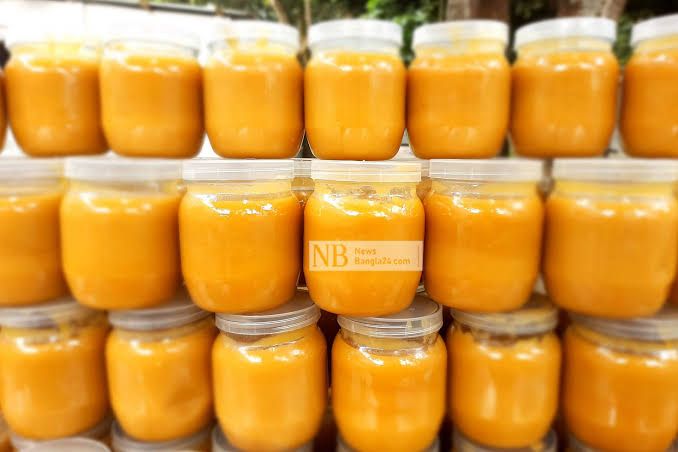
source
Versatile Use: Ghee can be used in various cooking methods, from sautéing and frying to drizzling over rice and vegetables. It also works well in baking and can substitute for butter in most recipes.
Lactose and Casein-Free: Because the milk solids are removed, ghee is lactose- and casein-free. This makes it suitable for those with lactose intolerance or casein sensitivity, unlike regular butter.
Ayurvedic Significance: In Ayurveda, ghee is considered a ‘sattvic’ food, meaning it promotes positivity and harmony within the body. It is often used in Ayurvedic medicine for its believed ability to balance the ‘doshas’ (bodily energies) and nourish the mind and body.
Nutritional Value of Ghee
Ghee is primarily made up of fats, with negligible carbohydrates and proteins. However, it offers several beneficial compounds within its fat content, which contribute to its nutritional value:
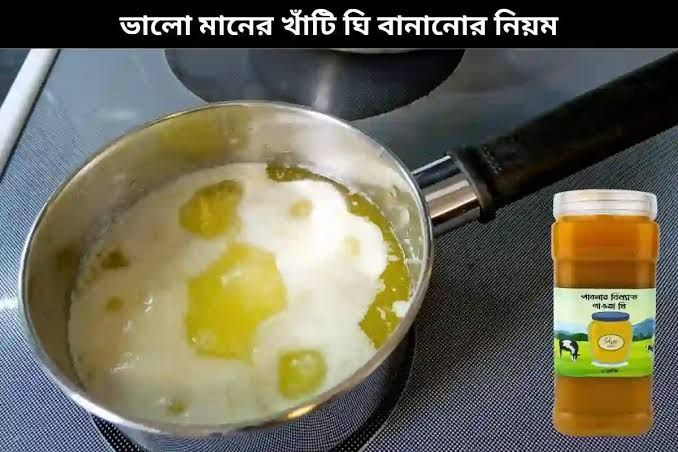
source
Fats: Ghee consists of about 99.9% fats, predominantly saturated fats. One tablespoon (approximately 14 grams) of ghee contains:
Total fat: 14 grams
Saturated fat: 9 grams
Monounsaturated fat: 4 grams
Polyunsaturated fat: 0.5 grams
Trans fats: None
The saturated fats in ghee, unlike those in processed foods, are naturally occurring and may support cellular health, hormone production, and the structure of cell membranes.
Vitamins: Ghee is a good source of fat-soluble vitamins like:
Vitamin A: Important for vision, immune health, and skin.
Vitamin E: Acts as an antioxidant, protecting cells from oxidative damage.
Vitamin K2: Plays a role in bone health by helping to bind calcium into the bone matrix.
Butyric Acid: Ghee contains butyric acid, a short-chain fatty acid known for its anti-inflammatory properties. Butyric acid supports digestive health by promoting a healthy gut environment and aiding in the maintenance of the intestinal lining.
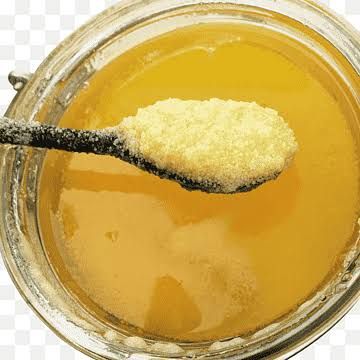
source
Omega Fatty Acids: Ghee made from grass-fed butter contains omega-3 and omega-9 fatty acids, which are beneficial for heart and brain health. Omega-3s are known to reduce inflammation, lower blood pressure, and support cognitive function.
Conjugated Linoleic Acid (CLA): Grass-fed ghee contains CLA, a polyunsaturated fat believed to aid in weight management, improve lean muscle mass, and reduce the risk of certain cancers. CLA may also support heart health and reduce inflammation.
Health Benefits of Ghee
Supports Digestive Health: The butyric acid in ghee has been shown to aid in digestion, reduce inflammation, and support the health of the intestinal lining. It can also be a soothing remedy for people with Irritable Bowel Syndrome (IBS) or other digestive issues.
Boosts Immune System: Ghee's concentration of antioxidants, including vitamin A and E, contributes to immune support. Antioxidants help neutralize free radicals, reducing oxidative stress and enhancing the body's defense against infections.
Enhances Nutrient Absorption: Ghee, as a fat source, aids in the absorption of fat-soluble vitamins (A, D, E, and K) from other foods. By consuming ghee with other nutritious foods, the body can better utilize essential nutrients, promoting overall health.
Anti-Inflammatory Properties: Due to butyric acid and CLA, ghee has anti-inflammatory properties that can reduce inflammation within the body. This is particularly helpful for individuals with conditions like arthritis, asthma, or inflammatory bowel disease.
Good for Heart Health (When Consumed in Moderation): The omega-3 fatty acids in grass-fed ghee support heart health by reducing inflammation and cholesterol levels. Studies have shown that in moderation, ghee can have a neutral or even beneficial effect on cardiovascular health.
Energy Booster: Ghee is rich in medium-chain triglycerides (MCTs), a type of fat that the body can quickly use for energy. Unlike other fats, MCTs are processed in the liver, which means they provide a quick energy source and may support mental clarity.
Promotes Skin and Hair Health: In Ayurveda, ghee is often applied topically for skin and hair nourishment. It acts as a natural moisturizer and may help with conditions like eczema and dry skin due to its rich fatty acids and antioxidants.
Lactose-Free Alternative: For those who are lactose intolerant or have a sensitivity to dairy proteins, ghee is a better choice than butter because the lactose and casein have been removed. This makes it easier to digest for individuals with these sensitivities.
source
Ghee’s unique properties, nutritional value, and versatility make it a highly prized cooking fat. Its preparation process, which involves clarifying butter to remove milk solids, gives it a longer shelf life, a high smoke point, and makes it suitable for those with lactose intolerance. With a variety of vitamins, beneficial fatty acids, and anti-inflammatory properties, ghee offers a range of health benefits when used in moderation. From supporting digestion to boosting the immune system and promoting heart health, ghee is a nutritious addition to a balanced diet and holds a valuable place in both traditional and modern cooking practices. Whether used in cooking, as a spread, or even in skincare routines, ghee remains a multifaceted and health-promoting ingredient.